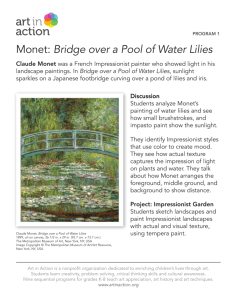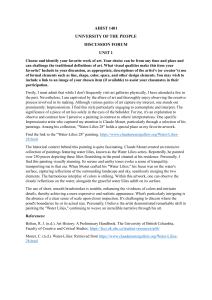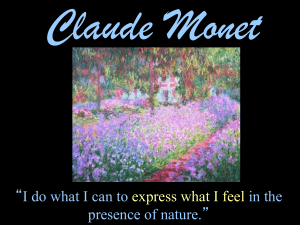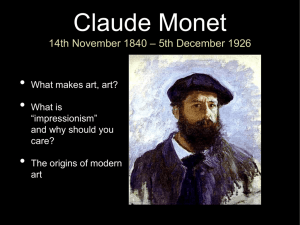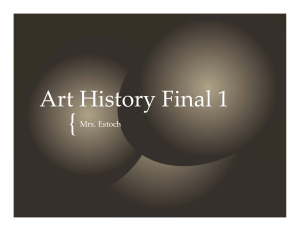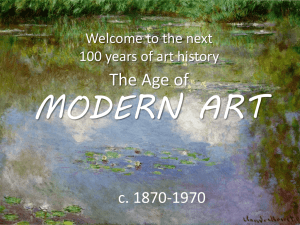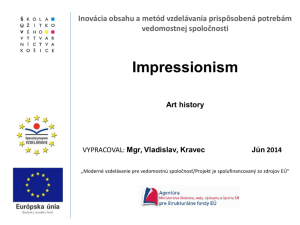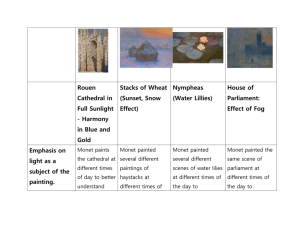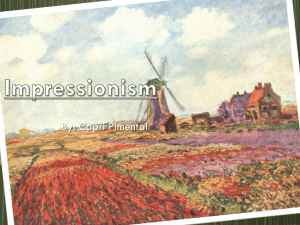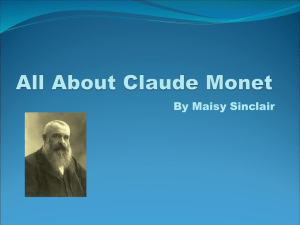Art History PowerPoint Project Artist List
advertisement
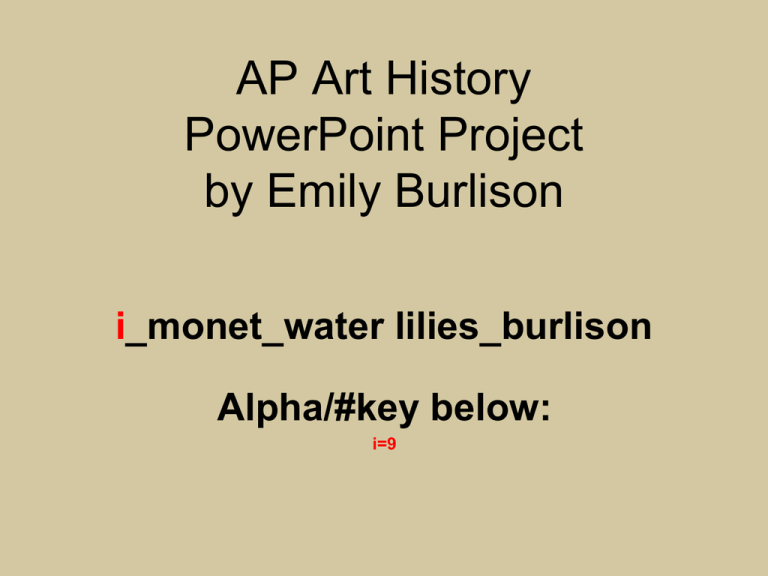
AP Art History PowerPoint Project by Emily Burlison i_monet_water lilies_burlison Alpha/#key below: i=9 100 WELL KNOWN WORKS OF ART #9 Monet, Water Lilies Interpreted Using The Feldman Model of Formal Analysis Feldman’s Model of Art Criticism From the work of Edmund Burke Feldman, During the late 1960’s and early 70’s 1. DescriptionList the visual qualities of the work that are obvious and immediate. “What do you see in the artwork”? Include content and subject matter in representational worksInclude abstract elements in nonrepresentational pieces. 2. AnalysisFocus on the formal aspects of elements of art, principles of design. “How does the artist create a center of interest? How does the use of color impact the painting?” 3. InterpretationPropose ideas for possible meaning based on evidence. “What was the artist trying to communicate”? 4. JudgmentDiscuss the overall strengths/success/merit of the work. How and why has this work achieved cultural value? Claude Monet Water Lilies, 1918-1926, Impressionist Movement, painting Giverny, France 1.DESCRIPTION a. Painting b. Oil on canvas c. 86.2” X 237” d. Water lilies in a pond e. Horizontal, asymmetrical f. Soft, depth g. Follows the flow of the water in the pond h. Objects grow smaller as the painting moves back in depth i. Blue green yellow red white color scheme j. Appears to have texture due to paint k. France-1920s (Giverny 1920-1926) 2.ANALYSIS a. Monet’s pond as seen through his cataracts b. Emphasis on the reflection of the lilies and the color yellow c. Harmonious and horizontally oriented d. Looks like a small part of an actual pond e. Mainly cool colors with a few warm ones, has a natural light, reflects the objects on the pond f. Deep and naturalistic depth g. Dynamic movement from the implied movement of water h. Shading due to light, gives depth i. Realistic proportions, slightly bigger than an actual water lily pond, naturalistic depth 3. Interpretation a. Created to inspire nature and give great beauty to whoever views it. b. The artwork shows how Monet loved nature, especially his water lily garden. c. The aim of his large Water Lilies paintings, Monet said, was to supply "the illusion of an endless whole, of water without horizon or bank.“3 4. Judgment a. What sets this work apart and makes it worth studying? (Water Lilies at The Art Institute of Chicago) b. How does this work fit into the context of what came before and after it? (Impressionism Smarthistory) c. How have critics, historians, and the public reacted to this work? (NY Times Review) d. How has this work changed the way art is viewed? (Water Lilies at Musée d’Orsay) e. Context with AP Exam: Link to AP Exam Q&A Compare and Contrast Impressionism Essay Claude Monet Essay Khan Academy Video Monet, 42 Amazing Paintings Summary IMPRESSIONISM 1865-1885 A style of painting in the 1860s's through 1880's; the subject matter was based on the natural appearance of objects, used dabs or strokes of primary unmixed colors in order to simulate actual reflected light.1 Claude Monet, Gustave Caillebotte, Mary Cassatt, Berthe Morisot, and Pierre-Auguste Renoir were important impressionist artists. Interesting Facts About Artist • His mentor, Eugene Boudin, taught him the “en plein air” technique of painting • Served in the First Regiment of African Light Calvary in Algeria for two years • Was a student of Charles Gleyre in Paris • Had two sons (Jean and Michel) with his first wife • Attempted suicide in 1868 by throwing himself into the Seine due to financial reasons • His cataracts influenced many of his later paintings • Died of lung cancer in 1926 His painting Impression, Sunrise hung in the first Impressionist exhibit in 1874. Art critic Louis Leroy coined the term “Impressionism” from the title of the painting.2 References 1. Impressionism definition http://www.merriamwebster.com/dictionary/impressionism 2. Claude Monet biography http://www.claudemonetgallery.org/biography.html 3. Water Lilies at the Museum of Modern Art http://www.moma.org/collection/object.php?object _id=80220
